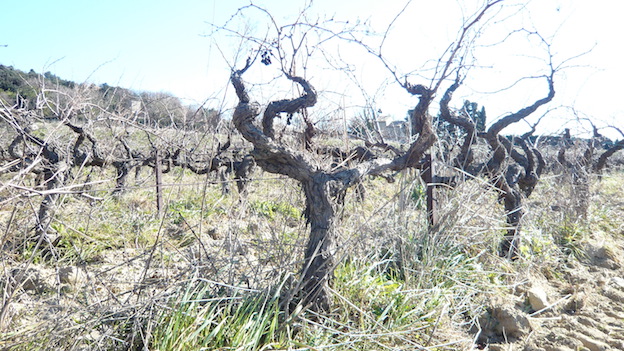Browse using the new Vinous website now. Launch →
Printed by, and for the sole use of . All rights reserved © 2015 Vinous Media
Vacqueyras: Excellent Values from the Southern Rhône
Fans of southern Rhône wines who are feeling sticker shock from current pricing for most Châteauneuf-du-Papes owe it to themselves to expand their buying net, and Vacqueyras is a great place to start. I would offer that same advice to wine lovers who have a rough time with the richness, power and high alcohol that characterize the majority of Châteauneufs. Vacqueyras is a cooler, higher-altitude sector of the region and its wines rely less heavily on Grenache; with greater emphasis on later-ripening, higher-acid Syrah and Mourvèdre, they present comparatively restrained, structured personalities.
Because Vacqueyras wines are less dependent on Grenache, producers here did not suffer the same severe crop losses in 2014 and 2013 that their colleagues in Châteauneuf-du-Pape did. And so most producers didn’t need to adjust their house styles—at least not too much—to compensate for a paltry Grenache yield, which was the case at a number of Châteauneuf addresses, especially those whose blends lean most heavily on that early-ripening variety.

Old vines are scattered widely throughout the Vacqueyras appellation
The 2014 Growing Season
The year began with a wet, late winter but April witnessed the onset of warm and dry conditions, pushing the vines out of their winter hibernation. The weather turned much warmer during the last couple days of May, followed by a mostly hot, even very hot June that set growers’ hopes high for a season of ample yields and ripe grapes. But July and August proved tricky, with overcast and rainy conditions prevailing, and fruit maturity slowed down considerably. Temperatures only really warmed up in mid-September and the resulting crop yielded wines that are naturally on the high side acidity-wise, with an emphasis on perfume, fresh fruit and gentle tannic structure. Based on the bottled 2014s from the southern Rhône that I have had the chance to try, I believe that these wines will drink well on the young side: they should provide plenty of pleasure for the less patient wine drinker and, especially, for restaurants that tend to put wines on their lists quickly.

The vineyards of Vacqueyras lie just below the peaks of Dentelles de Montmirail mountain range, in northern Provence
A Topsy-Turvy 2013
As was the case across the region, a cold start to the 2013 growing season in Vacqueyras was followed by a warm, sometimes hot June, and the flowering commenced in the middle of the month. The flowering then took place very rapidly—even a bit too quickly—and the result was a high percentage of shot berries that needed to be culled out by growers. The summer continued warm and dry but the damage caused by the poor, late flowering had been done, resulting in—no surprise—a much shorter than normal yield. The harvest was late, commencing in the third week of September under clement conditions and with almost all of the varieties reaching maturity at the same time.
The resulting wines mostly show good depth and structure thanks to the low overall yields and I don’t find them to be very far out of character for the region—in contrast to so many wines from Châteauneuf-du-Pape. I doubt that the wines will age on an especially long curve but they should provide a lot of upfront appeal. But then most wine lovers don’t buy Vacqueyras to squirrel away in the dark corners of their cellars.
You Might Also Enjoy
Châteauneuf-du-Pape Blanc Enters the 21st Century, Josh Raynolds, April 2016
Châteauneuf-du-Pape Reds: The Flamboyant 2014s and the Structured 2013s, Josh Raynolds, April 2016
2014 and 2013 Northern Rhône: Great Wines If You Can Find Them, Josh Raynolds, March 2016
Vacqueyras’ Promising 2013s and Ready to Drink 2012s, Josh Raynolds, May 2015
Gigondas — New Releases, Josh Raynolds, May 2015
Châteauneuf du Pape: The Lively 2013s and Lush 2012s, Josh Raynolds, April 2015
-- Josh Raynolds
Show all the wines (sorted by score)
- Alain Jaume & Fils
- Arnoux et Fils
- Bonpas
- Château des Roques
- Château du Trignon
- Delas Frères
- Domaine Cabassole
- Domaine de Boissan
- Domaine de la Charbonnière
- Domaine de la Colline St. Jean
- Domaine de la Ganse
- Domaine de la Pigeade
- Domaine de la Tête Noire
- Domaine de la Tourade
- Domaine de la Verde
- Domaine de l'Espigouette
- Domaine de Longue Toque
- Domaine des Amouriers
- Domaine de Verquière
- Domaine d'Ouréa
- Domaine du Grand Montmirail
- Domaine Fontaine du Clos
- Domaine Font Sarade
- Domaine La Bouïssiere
- Domaine La Fourmone
- Domaine La Garrigue
- Domaine La Ligière
- Domaine La Monardière
- Domaine La Roubine
- Domaine Le Clos des Cazaux
- Domaine Le Colombier
- Domaine Le Couroulu
- Domaine Le Sang des Cailloux
- Domaine Montbayon
- Domaine Montirius
- Domaine Palon
- Domaine Saint-Pierre
- Domaine Saint-Roch
- Famille Perrin
- Famille Tardieu (Tardieu-Laurent)
- Gabriel Meffre
- Gigondas La Cave
- La Bastide Saint Vincent
- Lavau
- Le Clos de Caveau
- LePlan-Vermeersch
- Les Halos de Jupiter
- Les Trois Couronnes
- Les Vins Skalli
- Maison Chapoutier
- Mas des Restanques
- Ogier
- Olivier Ravoire
- Paul Jaboulet Aîné
- Pierre Amadieu
- Pierre-Henri Morel
- Roucas Toumba
- Vignerons de Caractère
- Vignoble Alain Ignace
- Vignobles Cheron
